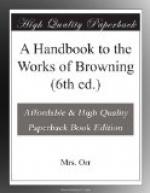With FRANCIS FURINI is a defence of the study of the nude, based on the life and work of this Florentine painter (born 1600), who at the age of forty also became a priest. According to his biographer, Filippo Baldinucci,[128] Furini was not only a skilful artist, but a conscientious priest, and a good man. No reproach attached to him but that he attained a special charm of colouring through the practice of painting very young women undraped; and we may infer that he repented this from the current report that when he felt himself dying he entreated those about him to have his pictures burnt. But Baldinucci also relates that he had a specious answer ready for whoever remonstrated with him on thus endangering his soul. The answer, which he frankly quotes, is by no means “specious” in the sense in which it is made; and Mr. Browning cannot believe that a man so inspired by the true artistic passion as those words imply, could in any circumstances become ashamed of the acts to which they refer. “If,” Furini says, “those scrupulous persons only knew what is the agony of endeavour with which the artist strives at faithfully imitating what he sees, they would also know how little room this leaves in him for the intrusion of alien” (immoral) “thoughts.” Mr. Browning goes farther still. He asserts not only the innocence, but the religiousness, of the painter’s art when directed towards the marvels of the female form. He declares its exercise, so directed, to be a subject, not of shame in the sight of the Creator, but of thanksgiving to Him, and also the best form in which human thanks can be conveyed; and he employs all the vividness of his illustration and all the force of his invective against the so-called artist who sees in the Divineness of female beauty only incitement to low desires; in the art which seeks to reproduce it only a cloak for their indulgence. His argument is very strong, and would be unanswerable, but for the touch of speciousness which Baldinucci by anticipation detects in it: Mr. Browning—as did Furini—regards the breach of formal chastity exclusively from the artist’s point of view. But he may also argue that this will in the long run determine that of the spectator and that the model herself is from the first amenable to it.
Mr. Browning lays stress upon the technical skill which results from the close copying of nature, and by virtue of which Furini must be styled a good painter, whether or not a great one: and though he has never underrated the positive value of technical skill, we do not feel that in this third page of the “parleyings” he gives to the inspiring thought as high a relative place as in his earlier works. The old convictions reappear at pages 182-3 of vol. xvi., when he asserts the danger in which the skilled hand may involve the artistic soul, by stifling its insight into the spiritual essence of fleshly things or silencing its testimony to it; when, too, he admits that not the least worthy of the “sacred” ones have been thus betrayed. He still, however, maintains that the true offender against Art will ever be the mock artist—the Philistine—who sees cause of offence in it.




